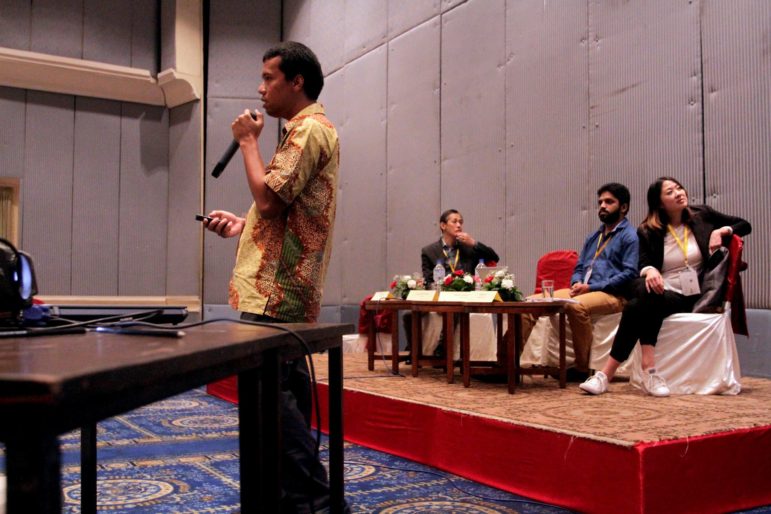
Finding Data in Asia: Learn jargon, negotiate, and scrape. Photo: Aseem Banstola.
As Mar Cabra of the Panama Papers team stated at the plenary session of the Second Asian Investigative Journalism Conference, massive electronic leaks are the new norm. Indeed, the smart use of data by journalists generally has been vital in uncovering big business scandals, exposing corruption, and revealing malpractices in both government and private sectors. And Asia and Asian journalists are an integral part of this global trend.
At the conference Saturday morning, three well known data journalists from Asia shared their experience on how they collect data for stories and the challenges of digging out more than is publicly available.
“It is not easy to get data from the governments in Asia,” observed Adek Media Roza, head of Katadata’s research unit in Jakarta, Indonesia. “But there are alternatives. We can find data by cooperating with institutions that own data and with open government champions.”
Roza was a veteran journalist when in 2014 he joined Katadata, an online media and research company that specializes in economic and business reporting. It also creates publications for companies and in return the holders give access to their data.
On August 17, Katadata released DATABOKS, an online directory containing 80,000 entries on business and the economy in Indonesia. Roza also cited Opentender.net as an important source for data at a time when public bodies are reluctant to be transparent.
“This institution has collected data of government projects and it is very important for us, because by looking at data we can find indicators of corruption,” he added.
Abhishek Waghmare of IndiaSpend, a pioneering data journalism initiative in India, spoke about the unique challenge of finding data in a country of 1.2 billion people where indicators of development, health, and economy vary from one state to another.
He gave examples of India’s health, migration, agricultural, and socio-economic sectors to show how journalists can dig deeper with data and find prevailing problems.
“Maharashtra, one of the biggest and most industrialized states in India, has the worst indicators of health, migration, agricultural and education,” Waghmare explained. “It also has the highest suicide rate of farmers, which shows the apathy of the system.”
Another story he cited: The National Rural Employment Guarantee Act of India is the biggest employment scheme in the world, but with each passing year the number of people it employs is drastically dropping. Similarly, there are government schemes for pregnant women in India but only 16 out of 100 get the benefit of this during delivery.
Despite a universe of data in India, much of it is unexplored and secondary data continues to be the biggest source of data, Waghmare noted. “But the goldmine isn’t the secondary data, it’s available but a lot of data is to be generated and gathered by institutions and people, which is actually the way to go.”
IndiaSpend recently launched a network of about 65 low-cost sensors to measure air quality in 15 Indian cities. Following the launch there was an experiment in which only odd-registration numbered vehicles would run during the day, followed by even-numbered vehicles the next day. Surprisingly, the pollution level didn’t decrease despite the fewer number of vehicles.
This means the air pollution may not be directly related to number of vehicles but that there are other reasons which need to be investigated, Waghmare said.
Data journalist Irene Jay Liu, who just left Thomson Reuters in Hong Kong, brought another perspective to the session. Liu shared ways to get data in Hong Kong and China, where there are no Right to Information laws and reporters must rely heavily on data made public by government bodies.
Hong Kong has a guidance called Code on Access to Information, which requires officials to respond, but they can always deny a public request, Liu explained. Hong Kong also has a government website — data.gov.hk — where people can access data, but the problem is it only hosts a fraction of what the government actually collects. Additionally, all the data available in English might not be there in Chinese version.
Given this environment, Liu said, it’s important to master the art of negotiation and be persistent. You have to negotiate on “a case by case basis. You have to be very careful about it. The conversation you have in Hong Kong would probably be different from the one you’d have in China or Indonesia or India.”
“Learning to use the terminologies that the government uses when asking for data will also help to collect data,” she added. “If you ask for information on traffic accidents, you won’t get it. But if you use the terminology they use in their own reports, it’s harder for them to refuse you.”
At the same time, the speakers noted, journalists be fully reliant on government bodies. A lot of private companies now have good data they are willing to share. And if there are problems finding data for one’s own country, cross-border collaboration can help.
Liu offered the following tips for journalists seeking to expand their reach of useful data:
- Use data scraping
- Take advantage of even temporarily available data and create a system to save them for future use
- Master the art of negotiation with government agencies
- Check with other communities if they received the same data
- Learn to use government jargon and terminology
- Don’t just rely on government; private business can be a good source
- Check out the Hong Kong business registry as many Asian businesses base their shell companies there
- Think beyond documents
- Be persistent and observant; prove officials wrong in thinking that journalists have very short attention spans

Sonia Awale is a Nepal-based freelance journalist with interests in science, health, and the environment. A recent graduate of the Journalism and Media Studies Centre at Hong Kong University, she has worked with Nepali Times, Malaysiakini, and China Daily.

i am from myanmar journalist and doing freelance.Same time an attend myanmar journalism Institute.